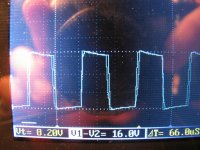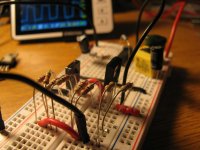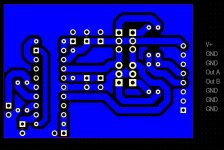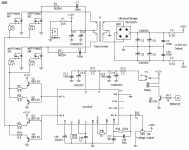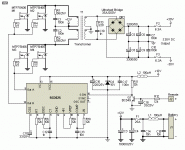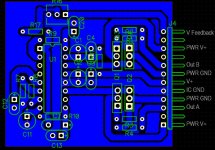Ok so now I have the totem pole stage working properly!!  Check out the photos below! All those resistors you see on the breadboard are actually four 27 ohm resistors in parallel to get me 6.9 ohms. Just like the R7 and R8 in Fig 1. The only problem is that when driving my mosfets, they still have the same stupid waveforms on them as before!! x-( This is extremely annoying and I would welcome any ideas as to why I am not able to switch these mosfets very well!
Check out the photos below! All those resistors you see on the breadboard are actually four 27 ohm resistors in parallel to get me 6.9 ohms. Just like the R7 and R8 in Fig 1. The only problem is that when driving my mosfets, they still have the same stupid waveforms on them as before!! x-( This is extremely annoying and I would welcome any ideas as to why I am not able to switch these mosfets very well!
You are using an out of date browser. It may not display this or other websites correctly.
You should upgrade or use an alternative browser.
You should upgrade or use an alternative browser.
12v 250w Car SMPS based off SG3525
- Thread starter codex653
- Start date
yeah i got it working!!  check this vid out!
check this vid out!
http://www.youtube.com/watch?v=9DZj8Bb43N0&feature=youtu.be
http://www.youtube.com/watch?v=9DZj8Bb43N0&feature=youtu.be
You got it working... good... just before I posted all this stuff I figured was needing tweaking :"::
I'm such a killjoy
For your experiments, use a much smaller drain pullup resistor, as 15k is too big; running the mosfets at ID=1mA is too low and their output capacitance will make those ramps that you see. I would go down to 1k ohm or 220ohms if you have 1/2W or 1W resistors.
A few things... you have a skeleton breadboard circuit with some parts missing.
You could use a resistor from pin 1 (+IN) to GND to force max. PWM duty cycle.
To keep the 3525 stable: You need a cap 0.1uF from pin 16 +5v to GND. Never connect pin 13 and pin 15 together without an RC filter between them. Elliot's schematic 89-f1 has an error where VC and VI are mixed up. You always want some filtering for the 3525's power pin from the main power.
For your totem-pole circuit, double check the transistor pinouts (ECB vs BCE) I get confused with different makes of the same transistor.
Your breadboard will need two separate ground rails to keep noise from being a problem. The PNP driver's collector is a source of noise and needs a dedicated ground bus+wire going to wherever the output MOSFET's source is. I use a single-point ground technique there. Noise won't show up until you are switching higher currents.
I'm such a killjoy
For your experiments, use a much smaller drain pullup resistor, as 15k is too big; running the mosfets at ID=1mA is too low and their output capacitance will make those ramps that you see. I would go down to 1k ohm or 220ohms if you have 1/2W or 1W resistors.
A few things... you have a skeleton breadboard circuit with some parts missing.
You could use a resistor from pin 1 (+IN) to GND to force max. PWM duty cycle.
To keep the 3525 stable: You need a cap 0.1uF from pin 16 +5v to GND. Never connect pin 13 and pin 15 together without an RC filter between them. Elliot's schematic 89-f1 has an error where VC and VI are mixed up. You always want some filtering for the 3525's power pin from the main power.
For your totem-pole circuit, double check the transistor pinouts (ECB vs BCE) I get confused with different makes of the same transistor.
Your breadboard will need two separate ground rails to keep noise from being a problem. The PNP driver's collector is a source of noise and needs a dedicated ground bus+wire going to wherever the output MOSFET's source is. I use a single-point ground technique there. Noise won't show up until you are switching higher currents.
You got it working... good... just before I posted all this stuff I figured was needing tweaking :"::
I'm such a killjoy
For your experiments, use a much smaller drain pullup resistor, as 15k is too big; running the mosfets at ID=1mA is too low and their output capacitance will make those ramps that you see. I would go down to 1k ohm or 220ohms if you have 1/2W or 1W resistors.
A few things... you have a skeleton breadboard circuit with some parts missing.
You could use a resistor from pin 1 (+IN) to GND to force max. PWM duty cycle.
To keep the 3525 stable: You need a cap 0.1uF from pin 16 +5v to GND. Never connect pin 13 and pin 15 together without an RC filter between them. Elliot's schematic 89-f1 has an error where VC and VI are mixed up. You always want some filtering for the 3525's power pin from the main power.
For your totem-pole circuit, double check the transistor pinouts (ECB vs BCE) I get confused with different makes of the same transistor.
Your breadboard will need two separate ground rails to keep noise from being a problem. The PNP driver's collector is a source of noise and needs a dedicated ground bus+wire going to wherever the output MOSFET's source is. I use a single-point ground technique there. Noise won't show up until you are switching higher currents.
Ok I will definitely be making these changes after the state basketball game today!
update on the transformer:
Epic Fail
Of course I only operated it in a forward converter type of arrangement and not the push-pull the circuit was designed for, but even still it should have worked ok....I had 4+4 turns on the primary and wound I think 15? turns on the secondary just for a random test and yet....when I connected only one half of the primary (to turn it into a forward converter), the waveform looked ok but the thing ramped up from 0.2A to 2A or more within a few seconds, and that's just unloaded!! so obviously I have not done anything right with the transformer and need some suggestions. Until then, I'm gonna start designing the pcb for the control circuitry
Epic Fail
Of course I only operated it in a forward converter type of arrangement and not the push-pull the circuit was designed for, but even still it should have worked ok....I had 4+4 turns on the primary and wound I think 15? turns on the secondary just for a random test and yet....when I connected only one half of the primary (to turn it into a forward converter), the waveform looked ok but the thing ramped up from 0.2A to 2A or more within a few seconds, and that's just unloaded!! so obviously I have not done anything right with the transformer and need some suggestions. Until then, I'm gonna start designing the pcb for the control circuitry
If you are driving only one winding (1/2 of push-pull) with no secondary load, the transformer core will magnetize and saturate. Each pulse set, you need to reset the core's flux by doing the second half of push-pull, or have a rectifier+load on the secondary, like a forward converter.
Also, those PC SMPS transformers have a copper-foil electrostatic shield that looks like a shorted turn? I'm not sure but I took a few apart (there's a thread somewhere on how to do that) and wondered how a full wrap of copper tape works.
Just go for push-pull. You can always lower Vcc to 8-10V for your tests. Generally, I only have blow-ups on my bench if the transformer gets saturated from too few turns on the primary or too high Vcc, or no snubber/zener clamp network for the mosfets
from too few turns on the primary or too high Vcc, or no snubber/zener clamp network for the mosfets  to prevent spikes from over-voltaging them.
to prevent spikes from over-voltaging them.
Also, those PC SMPS transformers have a copper-foil electrostatic shield that looks like a shorted turn? I'm not sure but I took a few apart (there's a thread somewhere on how to do that) and wondered how a full wrap of copper tape works.
Just go for push-pull. You can always lower Vcc to 8-10V for your tests. Generally, I only have blow-ups on my bench if the transformer gets saturated
If you are driving only one winding (1/2 of push-pull) with no secondary load, the transformer core will magnetize and saturate. Each pulse set, you need to reset the core's flux by doing the second half of push-pull, or have a rectifier+load on the secondary, like a forward converter.
Also, those PC SMPS transformers have a copper-foil electrostatic shield that looks like a shorted turn? I'm not sure but I took a few apart (there's a thread somewhere on how to do that) and wondered how a full wrap of copper tape works.
Just go for push-pull. You can always lower Vcc to 8-10V for your tests. Generally, I only have blow-ups on my bench if the transformer gets saturatedfrom too few turns on the primary or too high Vcc, or no snubber/zener clamp network for the mosfets
to prevent spikes from over-voltaging them.
AH HAH!
As for the electrostatic shield, I've seen quite a few of those as well on ones I have taken apart. There was actually 2 of them in the transformer I am rewinding for this supply. What I have discovered is that it is NOT a shorted turn, but rather a turn whose endings are insulated from each other. So it wraps around the core maybe 1.2 times but there is no actual connection to itself.
First round of PCB designs!
Hey everybody! Got Rev 01 of my controller board all laid out and ready to go! Any suggestions as to what I should do to improve it?
I made a combination of the two schematics posted below. I have the output stage and power filter section of Fig. 1 but the control circuitry of Fig. 9. That is how I have it set up on my breadboard.
Hey everybody! Got Rev 01 of my controller board all laid out and ready to go! Any suggestions as to what I should do to improve it?
I made a combination of the two schematics posted below. I have the output stage and power filter section of Fig. 1 but the control circuitry of Fig. 9. That is how I have it set up on my breadboard.
Attachments
That layout looks just fine as a start
I wonder what type of transformers you are using for this SMPS, or witch core
i was looking hard for you for an old schematic for a professional YAMAHA car audio amplifier, but i cannot find it.
Good luck
The type of transformer I'm gonna be using is from a 300W computer SMPS and is an "E" shaped core. Are you wanting to know dimensions??? I have no clue what all the technical specs like permeability and such are.
Hey thanks for looking for that!
Ok
Starting with EE core will take you some time to find the proper number of turns
There are MANY projects using that EE core directly in SMPS for car.
see attached complete project, but you have to translate!
But at lease you can use this layout and only thing u need to change is the Transformer, this will save you many hours of work!
At least this is a working circuit
Also check how EI33 core is used from an OLD PC SMPS directly !!
Regards
Starting with EE core will take you some time to find the proper number of turns
There are MANY projects using that EE core directly in SMPS for car.
see attached complete project, but you have to translate!
But at lease you can use this layout and only thing u need to change is the Transformer, this will save you many hours of work!
At least this is a working circuit
Also check how EI33 core is used from an OLD PC SMPS directly !!
Regards
Attachments
Just a quick look at your pcb and it looks good  but maybe a few small changes.
but maybe a few small changes.
I would have a trimpot to adjust duty cycle, in case you need less V or want to add regulation.
The driver transistors have high current 1-2A switching spikes, which can contaminate the SG3525's power or GND.
Look at Q3,Q4 collector traces running back to the IC. Instead I would run them to a seperate ground pin(s) - not connected to the SG3525 ground. This GND pin then connects to the output mosfet's source (the single point, star ground), so the high current path is not on your PCB.
Look at Q1,Q2 collector traces running back to the IC. Instead I would run the SG3525 +Vcc from a small R filter to have quiet power. See the 2.2R or 100uH inductor Elliot uses, it's important.
For the transformer, EC/ETD cores come in standard sizes, so you can measure the core height/width/thickness and have some idea.
I'm working on a 12V SMPS for car amp application and just got samples of Mag Inc. ZP42915TC and ZP43615TC for 200-400W range. I got raped with $97 in shipping via UPS x-( for 6 cores - so watch out for that!
I would have a trimpot to adjust duty cycle, in case you need less V or want to add regulation.
The driver transistors have high current 1-2A switching spikes, which can contaminate the SG3525's power or GND.
Look at Q3,Q4 collector traces running back to the IC. Instead I would run them to a seperate ground pin(s) - not connected to the SG3525 ground. This GND pin then connects to the output mosfet's source (the single point, star ground), so the high current path is not on your PCB.
Look at Q1,Q2 collector traces running back to the IC. Instead I would run the SG3525 +Vcc from a small R filter to have quiet power. See the 2.2R or 100uH inductor Elliot uses, it's important.
For the transformer, EC/ETD cores come in standard sizes, so you can measure the core height/width/thickness and have some idea.
I'm working on a 12V SMPS for car amp application and just got samples of Mag Inc. ZP42915TC and ZP43615TC for 200-400W range. I got raped with $97 in shipping via UPS x-( for 6 cores - so watch out for that!
Ok
Starting with EE core will take you some time to find the proper number of turns
There are MANY projects using that EE core directly in SMPS for car.
see attached complete project, but you have to translate!
But at lease you can use this layout and only thing u need to change is the Transformer, this will save you many hours of work!
At least this is a working circuit
Also check how EI33 core is used from an OLD PC SMPS directly !!
Regards
Yeah I'm expecting to have to do some trial and error on the transformer to get it right. Thanks for the files!!
Just a quick look at your pcb and it looks goodbut maybe a few small changes.
I would have a trimpot to adjust duty cycle, in case you need less V or want to add regulation.
The driver transistors have high current 1-2A switching spikes, which can contaminate the SG3525's power or GND.
Look at Q3,Q4 collector traces running back to the IC. Instead I would run them to a seperate ground pin(s) - not connected to the SG3525 ground. This GND pin then connects to the output mosfet's source (the single point, star ground), so the high current path is not on your PCB.
Look at Q1,Q2 collector traces running back to the IC. Instead I would run the SG3525 +Vcc from a small R filter to have quiet power. See the 2.2R or 100uH inductor Elliot uses, it's important.
For the transformer, EC/ETD cores come in standard sizes, so you can measure the core height/width/thickness and have some idea.
I'm working on a 12V SMPS for car amp application and just got samples of Mag Inc. ZP42915TC and ZP43615TC for 200-400W range. I got raped with $97 in shipping via UPS x-( for 6 cores - so watch out for that!
You got slapped with $97 dollars for SHIPPING?!?!?!
Controller PCB Update! Rev 02 Board
Hey so here are the changes I've made to the board! This is what I've done:
-Rerouted Q1-Q4 so they have shorter leads and take power directly from the battery and not the IC power rail
-Correctly rerouted the power filtering on the IC between Vcc and Vc
-Separated the Q2 and Q4 grounds from the IC ground
-Added a voltage feedback control (thanks redwire!!)
-Compressed and shortened a bit of the wiring, nothing fancy
What do you all think? Looking better?
Hey so here are the changes I've made to the board! This is what I've done:
-Rerouted Q1-Q4 so they have shorter leads and take power directly from the battery and not the IC power rail
-Correctly rerouted the power filtering on the IC between Vcc and Vc
-Separated the Q2 and Q4 grounds from the IC ground
-Added a voltage feedback control (thanks redwire!!)
-Compressed and shortened a bit of the wiring, nothing fancy
What do you all think? Looking better?
Attachments
Man it sure has been a while since ive posted on here! Ive been very busy lately with baseball season being in full swing, but hopefully ill be able to post some pics of the full smps board later tonight. I wont expect to get everything right on it, but this is a learning experience!  I've also had the chance to make some upgraded boards for my 150W audio amp in my room. Got some new features and pics ill be sharing with you later!!
I've also had the chance to make some upgraded boards for my 150W audio amp in my room. Got some new features and pics ill be sharing with you later!!
Updates With Some Misc Stuff Thrown In For Free 
OKKK slight digression from the SMPS discussion for a few moments, but here are some new things I've been able to get going for the overall "project". It consists of the SMPS, overhaul of the audio amp, and building a small variable power supply to test the new things I'm putting in the amp. First in the lineup today is: Variable Power Supply for Testing New Projects!!
That project are the first three pictures you see below and are from Rod Elliot's site (very reliable, highly recommend him!). I could of made something like this without Rod's help but...I got lazy and just ripped it off his site Instead of using the typical TO-22 packages for this board, I decided to use SMD components instead cause I have never incorporated SMD into a project before and thought it would be fun! It works really well and I actually have it sitting in front of me right now. If anybody wants a finished picture just ask.
Instead of using the typical TO-22 packages for this board, I decided to use SMD components instead cause I have never incorporated SMD into a project before and thought it would be fun! It works really well and I actually have it sitting in front of me right now. If anybody wants a finished picture just ask.
The second project (one of several) is for the audio amp! It is the last 4 pictures I posted. It consists of a turn on delay circuit to connect the speakers to the amplifier only once it has stabilized after turn on, and a loss of AC detector. What that does is as soon as I flip the switch to turn off the power to the amp the detector will automatically switch off the circuitry that keeps the speakers connected to the amplifier. Because there is no filter cap after the diodes in Fig 3, the removal of power to the circuit is virtually immediate. Therefore, the speakers will disconnect from the amp before the amp itself turns off (thanks to huge filter caps on the amp's power supply) and eliminating turn off thumps (if there is any). So no more turn on or turn off thumps, clicks, hissing, etc!! :w) Just a nice quiet amplifier.
The third thing is actually what I am working on right now and will maybe get some sort of picture posted tonight. Updates to come later! Until then....Sianara!
OKKK slight digression from the SMPS discussion for a few moments, but here are some new things I've been able to get going for the overall "project". It consists of the SMPS, overhaul of the audio amp, and building a small variable power supply to test the new things I'm putting in the amp. First in the lineup today is: Variable Power Supply for Testing New Projects!!
That project are the first three pictures you see below and are from Rod Elliot's site (very reliable, highly recommend him!). I could of made something like this without Rod's help but...I got lazy and just ripped it off his site
The second project (one of several) is for the audio amp! It is the last 4 pictures I posted. It consists of a turn on delay circuit to connect the speakers to the amplifier only once it has stabilized after turn on, and a loss of AC detector. What that does is as soon as I flip the switch to turn off the power to the amp the detector will automatically switch off the circuitry that keeps the speakers connected to the amplifier. Because there is no filter cap after the diodes in Fig 3, the removal of power to the circuit is virtually immediate. Therefore, the speakers will disconnect from the amp before the amp itself turns off (thanks to huge filter caps on the amp's power supply) and eliminating turn off thumps (if there is any). So no more turn on or turn off thumps, clicks, hissing, etc!! :w) Just a nice quiet amplifier.
The third thing is actually what I am working on right now and will maybe get some sort of picture posted tonight. Updates to come later! Until then....Sianara!
Attachments
-
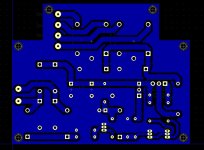 Delayed Turn On and Off Board Bottom.JPG79.6 KB · Views: 114
Delayed Turn On and Off Board Bottom.JPG79.6 KB · Views: 114 -
 Loss Of AC Detector.JPG22.4 KB · Views: 120
Loss Of AC Detector.JPG22.4 KB · Views: 120 -
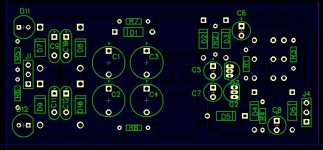 Dual Polarity 25v Variable Lab Supply Board Silkscreen.JPG66.4 KB · Views: 146
Dual Polarity 25v Variable Lab Supply Board Silkscreen.JPG66.4 KB · Views: 146 -
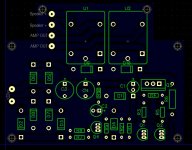 Delayed Turn On and Off Board Silkscreen.JPG94.1 KB · Views: 135
Delayed Turn On and Off Board Silkscreen.JPG94.1 KB · Views: 135 -
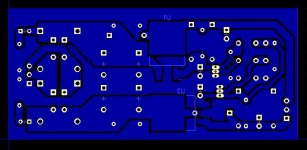 Dual Polarity 25v Variable Lab Supply Board Bottom.JPG52 KB · Views: 144
Dual Polarity 25v Variable Lab Supply Board Bottom.JPG52 KB · Views: 144 -
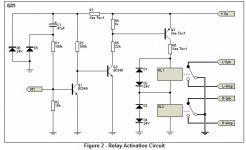 Relay Activation Circuit.JPG39.6 KB · Views: 164
Relay Activation Circuit.JPG39.6 KB · Views: 164 -
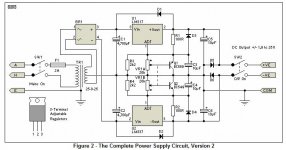 Dual Polarity 25v Variable Lab Supply Schematic.JPG53.3 KB · Views: 265
Dual Polarity 25v Variable Lab Supply Schematic.JPG53.3 KB · Views: 265
padmanabhan
New member
Hi codex653,
ref to your sch, when 3525A has sufficient drive output to drive MOSFET, what is the necessity of additional TOTEM POLE drivers using BD 139 and 140.And shorting the discharge pin without deadtime is it not risky.
regards
padmanabhan
ref to your sch, when 3525A has sufficient drive output to drive MOSFET, what is the necessity of additional TOTEM POLE drivers using BD 139 and 140.And shorting the discharge pin without deadtime is it not risky.
regards
padmanabhan
Hi codex653,
ref to your sch, when 3525A has sufficient drive output to drive MOSFET, what is the necessity of additional TOTEM POLE drivers using BD 139 and 140.And shorting the discharge pin without deadtime is it not risky.
regards
padmanabhan
Technically the SG3525 has enough current capability to drive the mosfets, but I found that in practice that did not work out so well. I used the totem pole driver to increase the peak current capacity to around 1.3A or so. The discharge pin is shorted?? I didn't think it was....which schematic are you referring to? I have posted several so far

